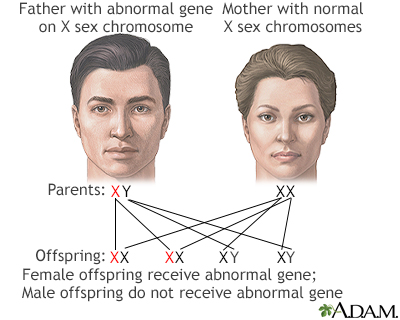Pregnancy SmartSiteTM
Inheritance - sex-linked recessive; Genetics - sex-linked recessive; X-linked recessive DefinitionSex-linked diseases are passed down through families through one of the X or Y chromosomes. X and Y are sex chromosomes. Dominant inheritance occurs when a variant gene from one parent causes disease, even though the matching gene from the other parent is normal. The variant gene dominates. But in recessive inheritance, both matching genes must be variant to cause disease. If only one gene in the pair is variant, the disease does not occur or it is mild. Someone who has one variant gene (but no symptoms) is called a carrier. Carriers can pass variant genes to their children. The term "sex-linked recessive" most often refers to X-linked recessive. InformationX-linked recessive diseases most often occur in males. Males have only one X chromosome. A single recessive gene on that X chromosome will cause the disease. The Y chromosome is the other half of the XY gene pair in the male. However, the Y chromosome doesn't contain most of the genes of the X chromosome. Because of that, it doesn't protect the male. Diseases such as hemophilia and Duchenne muscular dystrophy occur from a recessive gene on the X chromosome. TYPICAL SCENARIOS In each pregnancy, if the mother is a carrier of a certain disease (she has only one variant X chromosome) and the father is not a carrier for the disease, the expected outcome is:
If the father has the disease and the mother is not a carrier, the expected outcomes are:
This means that none of his children would actually show the signs of the disease, but the trait could be passed to his grandsons. X-LINKED RECESSIVE DISORDERS IN FEMALES Females can get an X-linked recessive disorder, but this is very rare. A variant gene on the X chromosome from each parent would be required, since a female has two X chromosomes. This could occur in the two scenarios below. In each pregnancy, if the mother is a carrier and the father has the disease, the expected outcomes are:
If both the mother and the father have the disease, the expected outcomes are:
The odds of either of these two scenarios are so low that X-linked recessive diseases are sometimes referred to as male only diseases. However, this is not technically correct. Female carriers can have a normal X chromosome that is abnormally inactivated. This is called skewed X-inactivation. These females may have symptoms similar to those of males, or they may have only mild symptoms. Females with Turner syndrome (who have only 1 X chromosome) may also have X-linked recessive conditions if they carry the recessive trait on the one X chromosome they have. ReferencesGregg AR, Kuller JA. Human genetics and patterns of inheritance. In: Lockwood CJ, Copel JA, Dugoff L, eds. Creasy and Resnik's Maternal-Fetal Medicine: Principles and Practice. 9th ed. Philadelphia, PA: Elsevier; 2023:chap 1. Jones KL, Jones MC, Campo M. Genetics, genetic counseling, and prevention. In: Jones KL, Jones MC, Campo MD, eds. Smith's Recognizable Patterns of Human Malformation. 8th ed. Philadelphia, PA: Elsevier; 2022:chap 2. Korf BR, Limdi NA. Principles of genetics. In: Goldman L, Cooney KA, eds. Goldman-Cecil Medicine. 27th ed. Philadelphia, PA: Elsevier; 2024:chap 31. Scott DA, Lee B. Patterns of genetic transmission. In: Kliegman RM, St. Geme JW, Blum NJ, et al, eds. Nelson Textbook of Pediatrics. 22nd ed. Philadelphia, PA: Elsevier; 2025:chap 97. Sondheimer N. Patterns of single-gene inheritance. In: Cohn RD, Scherer SW, Hamosh A, eds. Thompson & Thompson Genetics and Genomics in Medicine. 9th ed. Philadelphia, PA: Elsevier; 2024:chap 7. | |
| |
Review Date: 3/31/2024 Reviewed By: Anna C. Edens Hurst, MD, MS, Associate Professor in Medical Genetics, The University of Alabama at Birmingham, Birmingham, AL. Review provided by VeriMed Healthcare Network. Also reviewed by David C. Dugdale, MD, Medical Director, Brenda Conaway, Editorial Director, and the A.D.A.M. Editorial team. The information provided herein should not be used during any medical emergency or for the diagnosis or treatment of any medical condition. A licensed medical professional should be consulted for diagnosis and treatment of any and all medical conditions. Links to other sites are provided for information only -- they do not constitute endorsements of those other sites. No warranty of any kind, either expressed or implied, is made as to the accuracy, reliability, timeliness, or correctness of any translations made by a third-party service of the information provided herein into any other language. © 1997- A.D.A.M., a business unit of Ebix, Inc. Any duplication or distribution of the information contained herein is strictly prohibited. | |

 Genetics
Genetics
